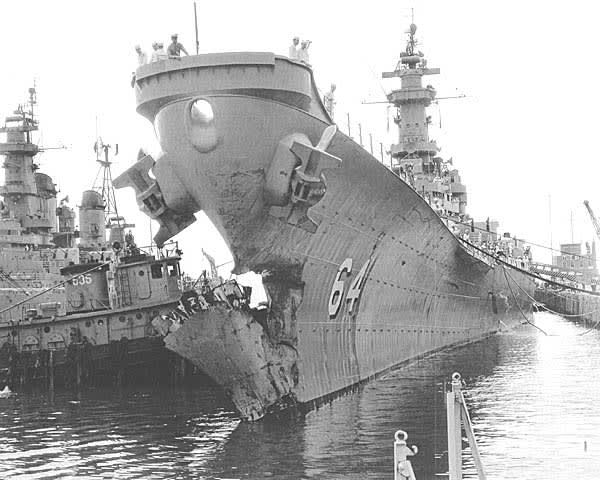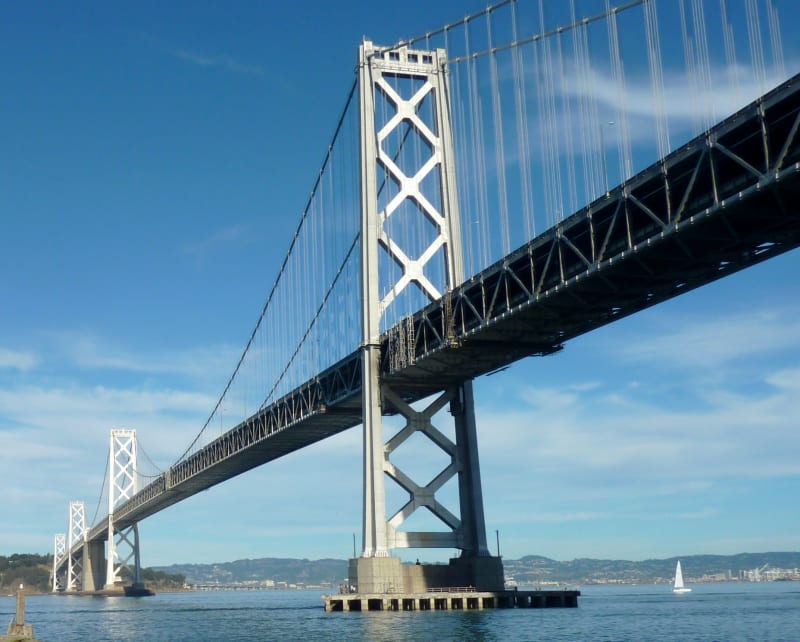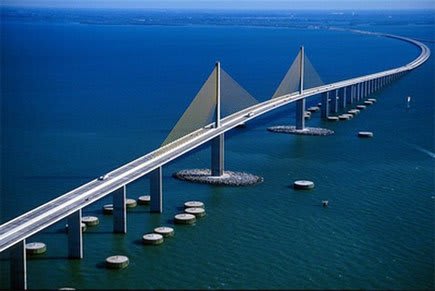Navigation
Install the app
How to install the app on iOS
Follow along with the video below to see how to install our site as a web app on your home screen.
Note: This feature may not be available in some browsers.
More options
Style variation
-
Congratulations cowski on being selected by the Eng-Tips community for having the most helpful posts in the forums last week. Way to Go!
You are using an out of date browser. It may not display this or other websites correctly.
You should upgrade or use an alternative browser.
You should upgrade or use an alternative browser.
Baltimore Bridge collapse after ship collision 125
- Thread starter Tomfh
- Start date
- Status
- Not open for further replies.
If you care to look at the map of the lower Chesapeake bay, there are NO "Tall Bridges" crossing either the mouth of the Chesapeake Bay or Hampton Roads.
So the possibility needs to be part of the design constraints.
Options include designs that limit damage to something that can be repaired in a reasonable amount of time (the CCBT above water sections) or making the sections that could have much longer repair times (the tunnels) such that a failure can not cascade to closing a ship channel.
Bridge strikes happen, to some degree it is inevitable,[URL unfurl="true" said:https://en.wikipedia.org/wiki/Chesapeake_Bay_Bridge%E2%80%93Tunnel[/URL]]High-level bridges were initially considered for traversing these channels. The United States Navy objected to bridging the Thimble Shoals Channel because a bridge collapse (possibly by sabotage) could cut Naval Station Norfolk off from the Atlantic Ocean. Maryland officials expressed similar concerns about the Chesapeake Channel and the Port of Baltimore.
So the possibility needs to be part of the design constraints.
Options include designs that limit damage to something that can be repaired in a reasonable amount of time (the CCBT above water sections) or making the sections that could have much longer repair times (the tunnels) such that a failure can not cascade to closing a ship channel.
And yes hazmat needs to go via surface bridges.[URL unfurl="true" said:https://en.wikipedia.org/wiki/Chesapeake_Bay_Bridge%E2%80%93Tunnel[/URL]]The CBBT has been closed three times for multiple days after being struck by watercraft:
[ul]
[li]In December 1967, coal barge Mohawk broke anchor and struck the bridge, closing it for two weeks for repairs.[/li]
[li]On January 21, 1970, the USS Yancey (AKA-93), a United States Navy attack cargo ship carrying 250 people, was at anchor near the bridge–tunnel. During a gale with winds gusting in excess of 50 miles per hour (80 km/h), the Yancey dragged its anchors and hit the bridge stern first, knocking out a 375-foot (114 m) segment of trestle. There were no vehicles on the bridge at the time of the impact, and no one was injured. During the 42 days it took to replace the damaged span, the Navy offered a free shuttle service for commuters using helicopters and LCUs.[/li]
[li]In 1972, the bridge was again impacted by a barge that had broken loose, closing it for two weeks while the span was repaired.[/li]
[li]Other, less significant strikes have caused shorter closures while the affected structures are inspected—most recently, a four hour closure after a barge strike in June 2011.[/li]
[/ul]
FacEngrPE said:the CCBT above water sections
I crossed the CBBT the morning of the incident, after watching the videos of the bridge fall over breakfast. When a container ship rolled into view through the fog...well let's just say I didn't have a warm and fuzzy feeling...
FacEngrPE,
Maybe not the lower Chesapeake, but the Chesapeake Bay Bridge at Annapolis is a 'tall bridge' downstream from Baltimore. Built in 1952. Second span built in 1973.
Those bridge strikes at the CBBT had little effect on shipping, as the main channels are over tunnels.
Maybe not the lower Chesapeake, but the Chesapeake Bay Bridge at Annapolis is a 'tall bridge' downstream from Baltimore. Built in 1952. Second span built in 1973.
Those bridge strikes at the CBBT had little effect on shipping, as the main channels are over tunnels.
Besides Sal with his "What is going on with shipping", there's also this guy, who seems pretty sharp:
spsalso
spsalso
-
2
- #166
3DDave said:The FAA KNEW 100% that anyone except flight crew in the cockpit was a bad deal and waited for 4 aircraft to be hijacked before requiring locks on doors and keeping hijackers away from the pilots.
Ah, but how many pilot suicides have we had since then? And the Greek hypoxia flight. Would those have happened if others had been able to access the cockpit?
Just saying, one has to be careful that in solving one problem, one does not create another.
And I'd say the biggest deterrent to a hijacking is a plane load of passengers who know that the rules have changed, and being hijacked may not mean a quick trip to some third world country.
LittleInch
Petroleum
How many big container ports are inland of bridges in the US?
Was this just a very rare freak crash?
It will probably now be being looked at by every big bridge authority, but could just be the worst set of circumstances here - relatively narrow bridge gap, container depot other side of it, ship lost power just at the wrong time.
Remember - More details = better answers
Also: If you get a response it's polite to respond to it.
Was this just a very rare freak crash?
It will probably now be being looked at by every big bridge authority, but could just be the worst set of circumstances here - relatively narrow bridge gap, container depot other side of it, ship lost power just at the wrong time.
Remember - More details = better answers
Also: If you get a response it's polite to respond to it.
LittleInch said:How many big container ports are inland of bridges in the US?
Not sure about containers specifically, but New Orleans (and essentially every port up river on the Mississippi) has terminals inland of bridges, part of the port of Jacksonville is up the St. Johns from a bridge, Charleston has oil and gas terminals and container terminals up the Cooper past a couple of large bridges, no containers but there is some decent shipping up the James River toward Richmond, VA that has to pass under the James River Bridge (not sure where or what, but I've had to wait on bulk carriers traversing the channel or work around them at anchor waiting for the bridge to lift), the Navy has a weapons station past a bridge up the York River, but that's mainly destroyers and cutters heading up there (everything else is small commercial watermen or pleasure boats), shipping on the Delaware River to Philly has to pass under a couple large bridges.
The list keeps going. But I'll stop. There are lots. And it's not just the big container ports that need to worry. Every facility needs to consider the vessels moving in and out of the harbor and determine what risk mitigation measures are appropriate.
I'd say yes, this was a freak accident...not because it's a bridge strike, but because of the scale. Bridge strikes are fairly common, but they're usually pleasure boaters. Professional mariners are pretty good at not hitting fixed objects. But when power goes out at the absolute worst moment...doesn't matter how good you are.
Retiredat46
Member
Do you suppose they'll scrap the Dali after this mishap? There's a chunk of the bow missing above the waterline, likely damage below the waterline, exposure to the horrendous stress of the collision, and a huge black cloud of bad luck hanging over the ship.
TugboatEng
Marine/Ocean
Not likely. Even if the damage to the bow is extensive a new bow can be fabricated and welded on.
Murph 9000
Computer
I'm not saying the damage will be directly comparable, but it was a similar-ish size of ship that grounded hard on a reef at 12 knots and did significant hull damage. The Exxon Valdez was repaired, renamed the Exxon Mediterranean, and had a fairly long life until she was written off in a collision with another ship many years later.
As a fairly young Neopanamax ship, I'm reasonably certain they will repair Dali.
As a fairly young Neopanamax ship, I'm reasonably certain they will repair Dali.
USS Wisconsin had a big chunk taken out of her bow when she collided with another ship in the fog just off the Virginia coast. There happened to be another ship of the same class under construction at the time, so she was ready for sea again and steamed for Spain 16 days after the incident.


It'll depend on the economics. The amount of new container ship capacity in build at the moment seems to be outstripping the combined effects of older ships being scrapped and the growth in cargo volume - though not the (hopefully) short term increase in requirement to accommodate all the trade that's being routed round the Cape of Good Hope.
"And I'd say the biggest deterrent to a hijacking is a plane load of passengers who know that the rules have changed, and being hijacked may not mean a quick trip to some third world country."
OK - Thanks! That makes total sense as a response. To an unasked question. The original question was, what should the FAA have done to stop a 9/11 style event, not, what is the best response AFTER the 9/11 event.
So the FAA should not require locked the doors now because, while it would have worked to stop 9/11 then, the passengers are considered the only line of defense now. Got it. Great answer. Demand the cockpit door remain open the next flight you are on because you think the pilots may commit suicide or pressurization will be lost and the crew won't respond correctly.
OK - Thanks! That makes total sense as a response. To an unasked question. The original question was, what should the FAA have done to stop a 9/11 style event, not, what is the best response AFTER the 9/11 event.
So the FAA should not require locked the doors now because, while it would have worked to stop 9/11 then, the passengers are considered the only line of defense now. Got it. Great answer. Demand the cockpit door remain open the next flight you are on because you think the pilots may commit suicide or pressurization will be lost and the crew won't respond correctly.
charliealphabravo
Structural
LittleInch said:How many big container ports are inland of bridges in the US?
It only took me about 20 minutes to scan the US coast on Google Maps looking at shipping yards and bridges. Neglecting channel depth I didn't see more than maybe one other bridge that would rank higher than the Baltimore bridge as a priority for protection. When you consider the width of the shipping lane, the number of lanes if one were to be obstructed, the type of the bridge and susceptibility of the piers to damage, the size/types/importance of upstream facilities.
How many big container ports are inland of bridges in the US?
The parts of San Francisco Bay require getting past at least Golden Gate Bridge, and the Bay Bridge
A part of LA Harbor requires passing a bridge
The naval base at San Diego requires passing bridge, but USN ships would never hit stuff, right?
TTFN (ta ta for now)
I can do absolutely anything. I'm an expert! faq731-376 forum1529 Entire Forum list
-
1
- #178
3DDave said:The FAA KNEW 100%...
No, the trillions of dollars and countless lives lost was not due to the FAA. It was due to a cultivated, cultural insecurity and who knows what kind of foreign policy rationales behind closed doors. September 11th could not have happened on September 12th, because the ruse was known. Thus, but for complacency, September 11th would never have happened.
Ultimate Safety is a never-winnable ideal. It only creates bubble boys incapable of living a relatively stress-free life.
I don't really see most bridges being able to survive such collisions undamaged; the Bay Bridge doesn't have much protection against a ship that masses 10x+ the mass of the supports. The only protection is really how much redundancy is built into the bridge itself.

TTFN (ta ta for now)
I can do absolutely anything. I'm an expert! faq731-376 forum1529 Entire Forum list

TTFN (ta ta for now)
I can do absolutely anything. I'm an expert! faq731-376 forum1529 Entire Forum list
-
1
- #180
Jeff Ostroff
Electrical

They need to add an island of rocks around these pylons like we did here in FL in Tampa Bay on the Sunshine Skyline Bridge, that is wide enough and large enough to allow a cargo ship to beach, with enough distance so the overhang of the ship sides or bow cannot reach it.
- Status
- Not open for further replies.
Similar threads
- Replies
- 13
- Views
- 13K
- Question
- Replies
- 39
- Views
- 21K
- Replies
- 17
- Views
- 11K
- Replies
- 25
- Views
- 25K
- Replies
- 33
- Views
- 3K
